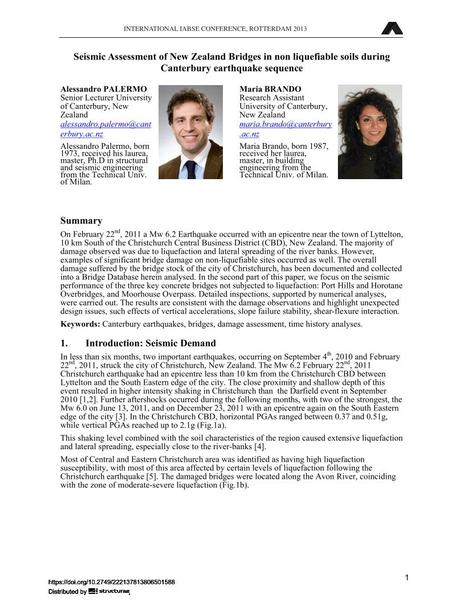Seismic Assessment of New Zealand Bridges in non liquefiable soils during Canterbury earthquake sequence

|
|
|||||||||||
Bibliographic Details
| Author(s): |
Alessandro Palermo
Maria Brando |
||||
|---|---|---|---|---|---|
| Medium: | conference paper | ||||
| Language(s): | English | ||||
| Conference: | IABSE Conference: Assessment, Upgrading and Refurbishment of Infrastructures, Rotterdam, The Netherlands, 6-8 May 2013 | ||||
| Published in: | IABSE Conference, Rotterdam, May 2013 | ||||
|
|||||
| Page(s): | 332-333 | ||||
| Total no. of pages: | 8 | ||||
| Year: | 2013 | ||||
| DOI: | 10.2749/222137813806501588 | ||||
| Abstract: |
On February 22nd, 2011 a Mw 6.2 Earthquake occurred with an epicentre near the town of Lyttelton, 10 km South of the Christchurch Central Business District (CBD), New Zealand. The majority of damage observed was due to liquefaction and lateral spreading of the river banks. However, examples of significant bridge damage on non-liquefiable sites occurred as well. The overall damage suffered by the bridge stock of the city of Christchurch, has been documented and collected into a Bridge Database herein analysed. In the second part of this paper, we focus on the seismic performance of the three key concrete bridges not subjected to liquefaction: Port Hills and Horotane Overbridges, and Moorhouse Overpass. Detailed inspections, supported by numerical analyses, were carried out. The results are consistent with the damage observations and highlight unexpected design issues, such effects of vertical accelerations, slope failure stability, shear-flexure interaction. |
||||
| Keywords: |
bridges damage assessment time-history analysis Time History Analysis Canterbury earthquakes
|
||||
